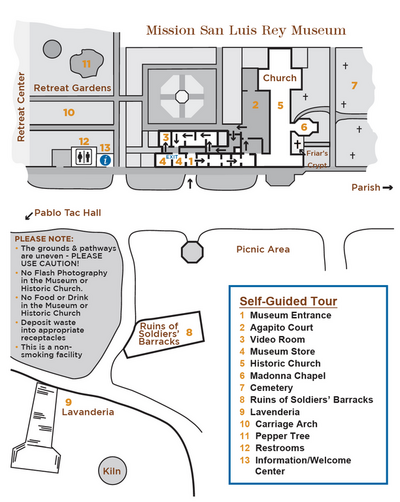Museum Self-guided Tour
Founded in 1798, by Fr. Fermin Lasuen, successor to Fr. Junipero Serra, Mission San Luis Rey became the largest of the 21 Spanish missions established in Alta California. This mission, the 18th in the chain, was named by the Spanish Viceroy after King Louis IX of France, a 13th-century saint, and patron of the Secular Franciscans.
We hope you enjoy exploring the grounds and buildings of this National Historic Landmark. Your self-guided tour through the museum will take you to the time of the Friars and early California.
POINTS OF INTEREST
MISSION MUSEUM (1)
Discover the story of Mission San Luis Rey and the history of the Mission era with a self-guided tour through period rooms, art galleries and courtyards within the Mission walls.
PERIOD ROOMS - Start your tour by viewing the lifestyle of Luiseño Indians; then move into rooms depicting life at the Mission. On display is the original document that President Abraham Lincoln signed giving the Mission back to the Catholic church. You will also see how the Mission is always continuing its efforts to preserve, restore and enhance this historic landmark allowing the mission legacy to continue for generations to come.
AGAPITO COURT (2) - This newly restored courtyard was once the private courtyard of the friars. The original fountains provided drinking water, and medicinal herbs and plants were grown here. To the left of Agapito Court, you can view the Sacred Garden, the private garden of the friars who live at the Mission.
VIDEO (3) - Your self-guided tour ends with a short video presentation about the history of Old Mission San Luis Rey. A CD of the 30-minute version is available for purchase at the Museum Store.
MUSEUM STORE (4) -The Museum Store has a wonderful selection of items from mission souvenirs and historical books to Catholic statues and prayer books.
HISTORIC MISSION CHURCH (5) - Enter through the front doors of the historic Church to see the amazing Spanish Colonial architecture, both Baroque and Classical in style. The paintings and decorations reflect the combination of Spanish and Luiseño Indian cultures. In addition to enjoying the beautiful art and architecture, the Historic Mission Church is open 365 days a year from 7am to 5pm for meditation and private prayer.
MADONNA CHAPEL (6) - Unique to Mission San Luis Rey is this octagonal room, originally a mortuary chapel, where church members were waked. Small doors on either side of the altar lead to hidden passageways – on the right, a staircase to a balcony for mourners; on the left, an entry to the altar for the friar saying the funeral service.
HISTORIC CEMETERY (7) - This is the oldest community burial ground in North County San Diego, dating back to 1798. It contains grave markers of early settlers, crypts of the friars, and a monument to the Luiseño Indians.
SOLDIER BARRACKS (8) - See the adobe ruins of the barracks that once housed the Spanish soldiers assigned to protect the Mission. It included apartments and a lookout tower. American troops were stationed here during the Mexican-American war, 1846-1848.
LAVANDERIA (9) - The elaborate “laundry” is where mission members bathed and washed their clothes. A gated arch fronted a grand staircase leading down to this area. Water poured through aqueducts into a series of tile and stone pools and spouted from gargoyles into lush orchards.
CARRIAGE ARCH (10) - The Carriage Arch is one of the last remnants of the arcade that formed the original quadrangle, a four-sided patio surrounded by buildings. The central patio, used for work and leisure activities, was bordered by workshops, classrooms, a kitchen, an infirmary, a winery and dormitories for Indian converts. The buildings are now the Retreat Center.
PEPPER TREE (11) - The oldest pepper tree in California can be seen from the viewing area near the Coffee Shop. Fr. Peyri planted it from seeds given to him in 1830 by a sailor from Peru. Branches of the old tree now need to be supported by tall stakes.
